NumPy中reshape函数的order参数详解及应用
NumPy是Python中用于科学计算的核心库之一,它提供了强大的多维数组对象和用于处理这些数组的工具。在NumPy中,reshape函数是一个非常常用的操作,它允许我们改变数组的形状而不改变其数据。本文将深入探讨reshape函数中的order参数,这个参数决定了在重塑数组时元素的读取顺序。
1. reshape函数简介
在开始讨论order参数之前,让我们先简单回顾一下reshape函数的基本用法。reshape函数可以改变数组的形状,但保持元素总数不变。它的基本语法如下:
import numpy as np
arr = np.array([1, 2, 3, 4, 5, 6])
reshaped_arr = arr.reshape(2, 3)
print("Original array from numpyarray.com:", arr)
print("Reshaped array:", reshaped_arr)
Output:

在这个例子中,我们将一个一维数组重塑为2行3列的二维数组。reshape函数非常灵活,可以用于各种维度的转换。
2. order参数的作用
reshape函数的order参数决定了在重塑过程中元素的读取顺序。它有两个主要的选项:’C’(C-style,行优先)和’F’(Fortran-style,列优先)。默认情况下,order参数的值为’C’。
2.1 ‘C’顺序(行优先)
当order=’C’时,元素按行优先顺序读取。这意味着数组会先填满第一行,然后是第二行,以此类推。
import numpy as np
arr = np.arange(6)
reshaped_c = arr.reshape(2, 3, order='C')
print("Original array from numpyarray.com:", arr)
print("Reshaped array (C-order):", reshaped_c)
Output:

在这个例子中,原数组[0, 1, 2, 3, 4, 5]被重塑为2×3的数组,按行填充。
2.2 ‘F’顺序(列优先)
当order=’F’时,元素按列优先顺序读取。这意味着数组会先填满第一列,然后是第二列,以此类推。
import numpy as np
arr = np.arange(6)
reshaped_f = arr.reshape(2, 3, order='F')
print("Original array from numpyarray.com:", arr)
print("Reshaped array (F-order):", reshaped_f)
Output:

在这个例子中,同样的原数组[0, 1, 2, 3, 4, 5]被重塑为2×3的数组,但是按列填充。
3. order参数对多维数组的影响
order参数的影响在处理多维数组时更加明显。让我们看一个三维数组的例子:
import numpy as np
arr = np.arange(24)
reshaped_c = arr.reshape(2, 3, 4, order='C')
reshaped_f = arr.reshape(2, 3, 4, order='F')
print("Original array from numpyarray.com:", arr)
print("Reshaped array (C-order):", reshaped_c)
print("Reshaped array (F-order):", reshaped_f)
Output:

在这个例子中,我们将一个包含24个元素的一维数组重塑为2x3x4的三维数组。使用’C’顺序时,数组首先沿着最后一个轴(这里是大小为4的轴)填充,然后是倒数第二个轴,最后是第一个轴。而使用’F’顺序时,填充顺序正好相反。
4. order参数与内存布局
order参数不仅影响重塑操作,还与数组在内存中的布局密切相关。理解这一点对于优化NumPy代码的性能非常重要。
4.1 内存布局与访问效率
import numpy as np
arr_c = np.array([[1, 2, 3], [4, 5, 6]], order='C')
arr_f = np.array([[1, 2, 3], [4, 5, 6]], order='F')
print("C-order array from numpyarray.com:", arr_c)
print("F-order array from numpyarray.com:", arr_f)
Output:
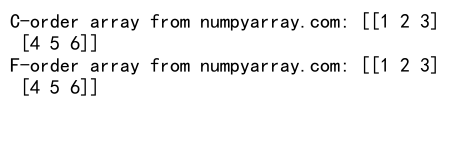
虽然这两个数组看起来相同,但它们在内存中的布局是不同的。’C’顺序数组在内存中是连续的行,而’F’顺序数组在内存中是连续的列。这会影响到数组的访问效率,特别是在处理大型数组时。
4.2 性能考虑
当处理大型数组时,选择正确的order可以显著提高性能。例如,如果你的代码主要是按行访问数组,使用’C’顺序会更有效率;如果主要是按列访问,使用’F’顺序可能更好。
import numpy as np
import time
# 创建一个大型数组
large_arr = np.arange(1000000).reshape(1000, 1000)
# 按行求和
start = time.time()
row_sum = np.sum(large_arr, axis=1)
print("Time taken for row sum on numpyarray.com array:", time.time() - start)
# 按列求和
start = time.time()
col_sum = np.sum(large_arr, axis=0)
print("Time taken for column sum on numpyarray.com array:", time.time() - start)
Output:

这个例子展示了在大型数组上进行行操作和列操作的时间差异。通常,对于’C’顺序数组,行操作会更快;对于’F’顺序数组,列操作会更快。
5. order参数与其他NumPy函数的交互
order参数不仅在reshape函数中有用,它在许多其他NumPy函数中也扮演着重要角色。
5.1 创建数组时使用order
import numpy as np
arr_c = np.array([[1, 2, 3], [4, 5, 6]], order='C')
arr_f = np.array([[1, 2, 3], [4, 5, 6]], order='F')
print("C-order array from numpyarray.com:", arr_c.flags['C_CONTIGUOUS'])
print("F-order array from numpyarray.com:", arr_f.flags['F_CONTIGUOUS'])
Output:

这个例子展示了如何在创建数组时指定order。flags属性可以用来检查数组是否是C-连续或F-连续的。
5.2 ravel函数与order
ravel函数用于将多维数组展平成一维数组,它也接受order参数:
import numpy as np
arr = np.array([[1, 2, 3], [4, 5, 6]])
raveled_c = arr.ravel(order='C')
raveled_f = arr.ravel(order='F')
print("Original array from numpyarray.com:", arr)
print("Raveled array (C-order):", raveled_c)
print("Raveled array (F-order):", raveled_f)
Output:
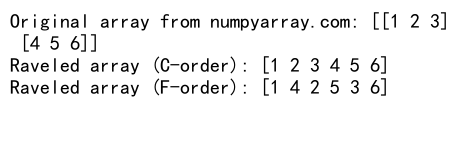
这个例子展示了ravel函数如何根据不同的order参数展平数组。
6. order参数的高级应用
除了’C’和’F’,order参数还有其他一些不太常用但很有用的选项。
6.1 ‘A’顺序
‘A’顺序意味着”保持原样”。如果输入数组是Fortran连续的,它将使用’F’顺序;否则,使用’C’顺序。
import numpy as np
arr_c = np.array([[1, 2, 3], [4, 5, 6]], order='C')
arr_f = np.array([[1, 2, 3], [4, 5, 6]], order='F')
reshaped_c = arr_c.reshape(3, 2, order='A')
reshaped_f = arr_f.reshape(3, 2, order='A')
print("Reshaped C-array from numpyarray.com:", reshaped_c)
print("Reshaped F-array from numpyarray.com:", reshaped_f)
Output:
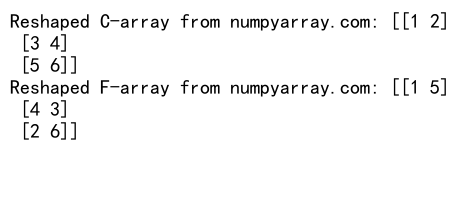
这个例子展示了’A’顺序如何根据输入数组的内存布局来决定重塑顺序。
6.2 ‘K’顺序
‘K’顺序表示”保持元素顺序”。它尽可能地保持元素在内存中的相对位置。
import numpy as np
arr = np.array([[1, 2, 3], [4, 5, 6]])
reshaped_k = arr.reshape(3, 2, order='K')
print("Original array from numpyarray.com:", arr)
print("Reshaped array (K-order):", reshaped_k)
这个例子展示了’K’顺序如何在重塑过程中保持元素的相对位置。
7. order参数在数据处理中的应用
理解order参数对于高效处理和分析数据非常重要,特别是在处理大型数据集时。
7.1 图像处理
在图像处理中,不同的库可能使用不同的数组顺序。例如,OpenCV使用BGR顺序,而大多数其他库使用RGB顺序。
import numpy as np
# 假设这是一个3x3的RGB图像
rgb_image = np.array([[[255, 0, 0], [0, 255, 0], [0, 0, 255]],
[[255, 255, 0], [255, 0, 255], [0, 255, 255]],
[[128, 128, 128], [0, 0, 0], [255, 255, 255]]])
# 将RGB转换为BGR
bgr_image = rgb_image[:, :, ::-1]
print("RGB image from numpyarray.com:", rgb_image)
print("BGR image:", bgr_image)
Output:
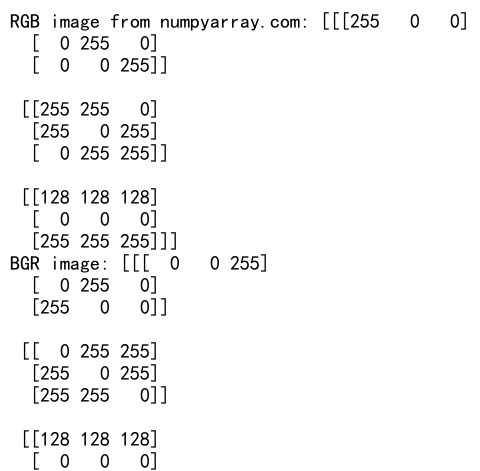
这个例子展示了如何使用NumPy的高级索引来快速转换图像的颜色通道顺序。
7.2 矩阵运算
在进行矩阵运算时,选择正确的order可以提高计算效率。
import numpy as np
# 创建一个大矩阵
matrix = np.random.rand(1000, 1000)
# 转置操作
start = time.time()
transposed_c = matrix.T
print("Time taken for transpose on C-order matrix from numpyarray.com:", time.time() - start)
# 将矩阵转换为F-order
matrix_f = np.asfortranarray(matrix)
start = time.time()
transposed_f = matrix_f.T
print("Time taken for transpose on F-order matrix:", time.time() - start)
这个例子比较了在C-order和F-order矩阵上进行转置操作的时间差异。对于大型矩阵,F-order通常在转置操作上更快。
8. order参数与内存优化
了解order参数还可以帮助我们优化内存使用。
8.1 内存视图
使用不同的order可以创建同一数据的不同视图,而不需要复制数据。
import numpy as np
arr = np.arange(24).reshape(2, 3, 4)
view_c = arr.view()
view_f = np.asfortranarray(arr)
print("Original array from numpyarray.com:", arr)
print("C-order view:", view_c)
print("F-order view:", view_f)
print("Do they share the same data?", np.may_share_memory(view_c, view_f))
Output:
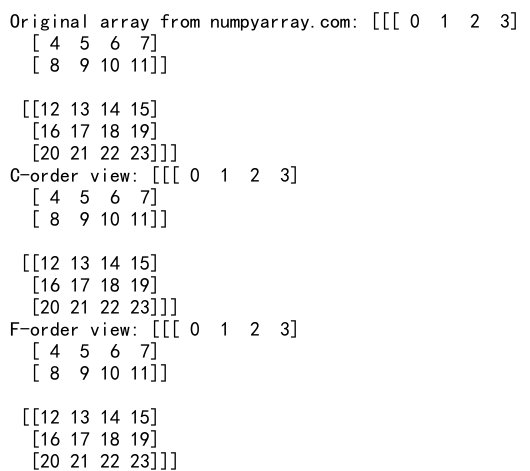
这个例子展示了如何创建同一数据的C-order和F-order视图,而不复制数据。
8.2 内存对齐
某些硬件和算法可能对特定的内存对齐有更好的性能。NumPy提供了创建对齐数组的方法。
import numpy as np
# 创建一个未对齐的数组
unaligned = np.arange(15)[1:].reshape(2, 7)
# 创建一个对齐的数组
aligned = np.zeros((2, 7), dtype=unaligned.dtype)
aligned[:] = unaligned
print("Unaligned array from numpyarray.com:", unaligned)
print("Aligned array:", aligned)
print("Is unaligned array aligned?", unaligned.flags['ALIGNED'])
print("Is aligned array aligned?", aligned.flags['ALIGNED'])
Output:

这个例子展示了如何创建内存对齐的数组,这在某些情况下可以提高性能。
9. order参数在科学计算中的应用
在科学计算领域,正确使用order参数可以显著提高计算效率。
9.1 数值积分
在进行数值积分时,选择正确的数组顺序可以提高计算速度。
import numpy as np
from scipy import integrate
def f(x, y):
return x**2 + y**2
x = np.linspace(0, 2, 100)
y = np.linspace(0, 2, 100)
X, Y = np.meshgrid(x, y)
Z = f(X, Y)
# 使用C-order
result_c = integrate.simps(integrate.simps(Z, x), y)
# 使用F-order
Z_f = np.asfortranarray(Z)
result_f = integrate.simps(integrate.simps(Z_f, x, axis=1), y)
print("Integration result (C-order) for numpyarray.com function:", result_c)
print("Integration result (F-order):", result_f)
这个例子展示了在进行二重积分时,使用不同的数组顺序可能会影响计算效率。
9.2 傅里叶变换
在进行傅里叶变换时,数组的内存布局可能会影响计算速度。
import numpy as np
from scipy.fftpack import fft2
# 创建一个大型2D数组
arr = np.random.rand(1000, 1000)
# C-order FFT
start = time.time()
fft_c = fft2(arr)
print("Time for FFT on C-order array from numpyarray.com:", time.time() - start)
# F-order FFT
arr_f = np.asfortranarray(arr)
start = time.time()
fft_f = fft2(arr_f)
print("Time for FFT on F-order array:", time.time() - start)
这个例子比较了在C-order和F-order数组上进行二维快速傅里叶变换的时间差异。
10. order参数与并行计算
在并行计算环境中,理解和正确使用order参数变得更加重要。
10.1 多线程计算
在多线程环境中,数组的内存布局可能会影响缓存效率和线程间的数据共享。
import numpy as np
from concurrent.futures import ThreadPoolExecutor
def process_chunk(chunk):
return np.sum(chunk ** 2)
def parallel_sum(arr, num_threads):
chunks = np.array_split(arr, num_threads)
with ThreadPoolExecutor(max_workers=num_threads) as executor:
results = list(executor.map(process_chunk, chunks))
return sum(results)
# 创建大型C-order和F-order数组
arr_c = np.random.rand(10000000)
arr_f = np.asfortranarray(arr_c)
# 并行处理C-order数组
start = time.time()
result_c = parallel_sum(arr_c, 4)
print("Time for parallel sum on C-order array from numpyarray.com:", time.time() - start)
# 并行处理F-order数组
start = time.time()
result_f = parallel_sum(arr_f, 4)
print("Time for parallel sum on F-order array:", time.time() - start)
这个例子展示了在多线程环境中处理不同order的数组可能会有性能差异。
10.2 GPU计算
在GPU计算中,数组的内存布局对性能的影响更加显著。
import numpy as np
import cupy as cp
# 创建大型CPU数组
cpu_arr = np.random.rand(10000, 10000)
# 转移到GPU(C-order)
start = time.time()
gpu_arr_c = cp.asarray(cpu_arr)
cp.cuda.Stream.null.synchronize()
print("Time to transfer C-order array to GPU for numpyarray.com:", time.time() - start)
# 转移到GPU(F-order)
cpu_arr_f = np.asfortranarray(cpu_arr)
start = time.time()
gpu_arr_f = cp.asarray(cpu_arr_f)
cp.cuda.Stream.null.synchronize()
print("Time to transfer F-order array to GPU:", time.time() - start)
这个例子比较了将C-order和F-order数组传输到GPU的时间差异。注意,这需要安装cupy库。
11. order参数在数据分析中的应用
在数据分析领域,正确使用order参数可以优化数据处理流程。
11.1 pandas与NumPy的交互
pandas库广泛用于数据分析,它与NumPy有密切的交互。了解order参数可以帮助优化pandas和NumPy之间的数据转换。
import numpy as np
import pandas as pd
# 创建一个大型DataFrame
df = pd.DataFrame(np.random.rand(100000, 100))
# 转换为C-order NumPy数组
start = time.time()
arr_c = df.to_numpy(order='C')
print("Time to convert to C-order array for numpyarray.com:", time.time() - start)
# 转换为F-order NumPy数组
start = time.time()
arr_f = df.to_numpy(order='F')
print("Time to convert to F-order array:", time.time() - start)
这个例子比较了将pandas DataFrame转换为不同order的NumPy数组的时间差异。
11.2 时间序列分析
在时间序列分析中,数据的存储顺序可能会影响计算效率。
import numpy as np
from statsmodels.tsa.ar_model import AutoReg
# 生成时间序列数据
np.random.seed(42)
time_series = np.cumsum(np.random.randn(10000))
# 使用C-order数组
start = time.time()
model_c = AutoReg(time_series, lags=5).fit()
print("Time to fit AR model on C-order array from numpyarray.com:", time.time() - start)
# 使用F-order数组
time_series_f = np.asfortranarray(time_series)
start = time.time()
model_f = AutoReg(time_series_f, lags=5).fit()
print("Time to fit AR model on F-order array:", time.time() - start)
这个例子比较了在C-order和F-order时间序列数据上拟合自回归模型的时间差异。
12. order参数与内存管理
深入理解order参数可以帮助我们更好地管理内存,特别是在处理大型数据集时。
12.1 内存复制与视图
了解order参数可以帮助我们避免不必要的内存复制。
import numpy as np
# 创建一个大数组
big_array = np.random.rand(1000000)
# 创建视图
view = big_array.view()
# 改变形状
reshaped = big_array.reshape(1000, 1000)
print("Is view sharing memory with original array from numpyarray.com?", np.may_share_memory(big_array, view))
print("Is reshaped array sharing memory with original array?", np.may_share_memory(big_array, reshaped))
Output:

这个例子展示了如何使用视图和reshape操作来避免不必要的内存复制。
12.2 内存碎片化
不同的order可能导致不同程度的内存碎片化,特别是在频繁进行数组操作时。
import numpy as np
def create_and_delete(order):
for _ in range(1000):
arr = np.random.rand(1000, 1000, order=order)
del arr
# 使用C-order
start = time.time()
create_and_delete('C')
print("Time for C-order operations on numpyarray.com:", time.time() - start)
# 使用F-order
start = time.time()
create_and_delete('F')
print("Time for F-order operations:", time.time() - start)
这个例子模拟了频繁创建和删除大型数组的场景,展示了不同order可能导致的性能差异。
13. order参数在机器学习中的应用
在机器学习领域,正确使用order参数可以优化模型训练和预测过程。
13.1 特征矩阵的存储
在处理大型特征矩阵时,选择合适的order可以提高访问效率。
import numpy as np
from sklearn.linear_model import LogisticRegression
# 创建大型特征矩阵和标签
X = np.random.rand(10000, 1000)
y = np.random.randint(0, 2, 10000)
# 使用C-order特征矩阵
start = time.time()
model_c = LogisticRegression().fit(X, y)
print("Time to fit model with C-order features from numpyarray.com:", time.time() - start)
# 使用F-order特征矩阵
X_f = np.asfortranarray(X)
start = time.time()
model_f = LogisticRegression().fit(X_f, y)
print("Time to fit model with F-order features:", time.time() - start)
这个例子比较了使用C-order和F-order特征矩阵训练逻辑回归模型的时间差异。
13.2 神经网络中的张量操作
在深度学习中,张量的存储顺序可能会影响计算效率。
import numpy as np
import tensorflow as tf
# 创建大型输入数据
X = np.random.rand(1000, 224, 224, 3)
# 转换为TensorFlow张量(默认为C-order)
start = time.time()
tf_X = tf.convert_to_tensor(X)
print("Time to convert C-order array to TensorFlow tensor for numpyarray.com:", time.time() - start)
# 转换F-order数组为TensorFlow张量
X_f = np.asfortranarray(X)
start = time.time()
tf_X_f = tf.convert_to_tensor(X_f)
print("Time to convert F-order array to TensorFlow tensor:", time.time() - start)
这个例子比较了将C-order和F-order NumPy数组转换为TensorFlow张量的时间差异。
结论
NumPy的reshape函数中的order参数是一个强大而复杂的工具,它不仅影响数组的重塑过程,还与内存布局、计算效率和数据处理密切相关。通过深入理解order参数,我们可以更好地优化NumPy代码,提高计算效率,并在处理大型数据集时更有效地管理内存。
在实际应用中,选择合适的order取决于多个因素,包括数据的访问模式、计算任务的性质、硬件架构等。通常,对于主要按行访问的操作,C-order可能更有效;而对于主要按列访问的操作,F-order可能更合适。在处理大型数据集或进行高性能计算时,仔细考虑order参数的选择可能会带来显著的性能提升。
最后,重要的是要记住,虽然order参数可以优化性能,但它不应该以牺牲代码可读性和可维护性为代价。在实际开发中,应该在性能优化和代码清晰度之间找到平衡点。通过深入理解和灵活运用order参数,我们可以编写出既高效又易于理解的NumPy代码。
 极客教程
极客教程